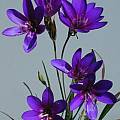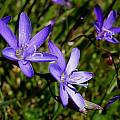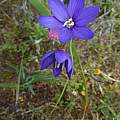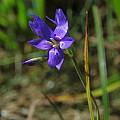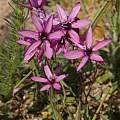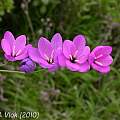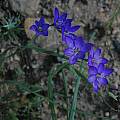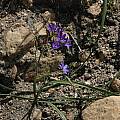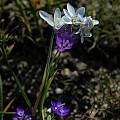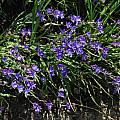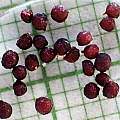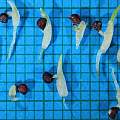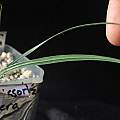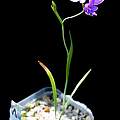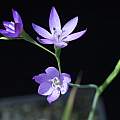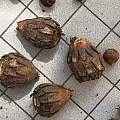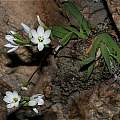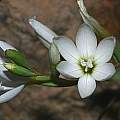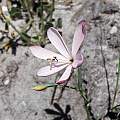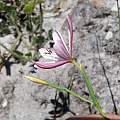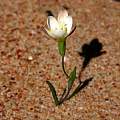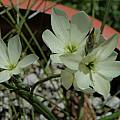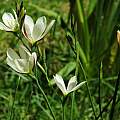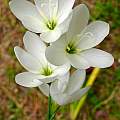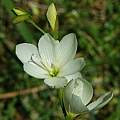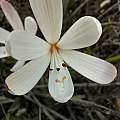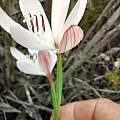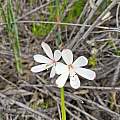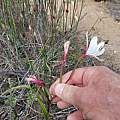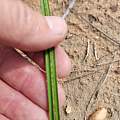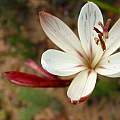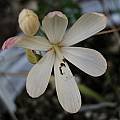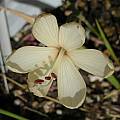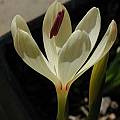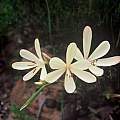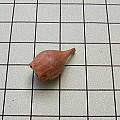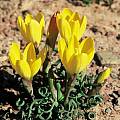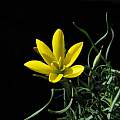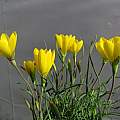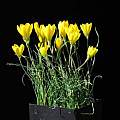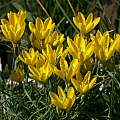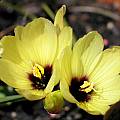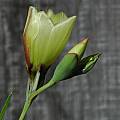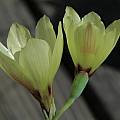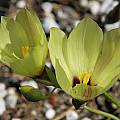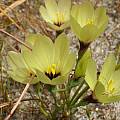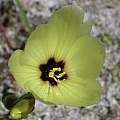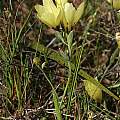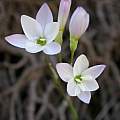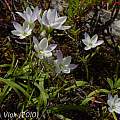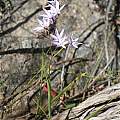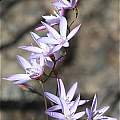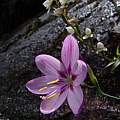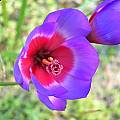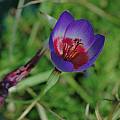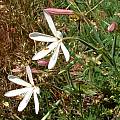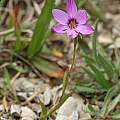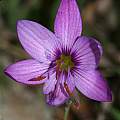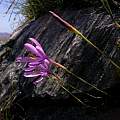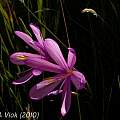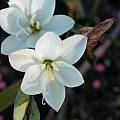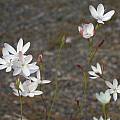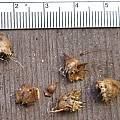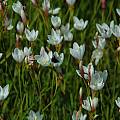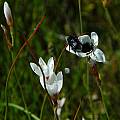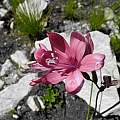Geissorhiza species a-g are found on this wiki page. See the links below for information about this genus and other species.
Geissorhiza index - Geissorhiza species h-l - Geissorhiza species m-z
Geissorhiza aspera Goldblatt is found on mostly sandy soils, flats, and slopes in the western Cape. It has blue to violet flowers that appear in spring. The first photo was taken by Bill Dijk, the next two by Cameron McMaster at Hermanus and Jacobsbaai and the fourth by Mary Sue Ittner at Darling. The fifth photo taken by Rod Saunders near Malmesbury after a burn was originally thought to be a new species, but subsequently was determined to be a different form of this species. The last photo from the book Plants of the Klein Karoo courtesy of Jan and Anne Lise Schutte-Vlok.
Photos by Bob Rutemoeller and Mary Sue Ittner taken at Lion’s Head, Table Mountain National Park, September 2006 where they were blooming in mass and one was white.
Photographs by M.Gastil-Buhl show seed acquired from Silverhill Seeds on a 1 mm grid in photo 1 before germination and in photo 2 germinated seeds from BX 317 #17 donated by Nhu Nguyen. Seed was germinated in 3 months on damp filter papers in a closed dish at warm day and cold night temperatures (approximately 60-75 °F day and 35-45 °F night). The resulting seedling in photo 3 has several leaves in its second year of growth. Photo 5 shows it blooming in March. The last photo shows corms from these same seeds 4 years later.
Geissorhiza bolusii Baker grows on damp shady, sandstone slopes in moss in the western Cape. It grows from 3 to 10 cm and has small white flowers in a two to eight flowered spike. Leaves are lanceolate to ovate with the lower ones usually prostrate. This species blooms October to January. Photos from Andrew Harvie taken near Bainskloof.
Geissorhiza bonaspei Goldblatt, also seen spelled Geissorhiza bonae-spei Goldblatt, syn. Engysiphon pictus (R.C.Foster) G.J.Lewis, grows in rocky sandstone slopes in fynbos in the Southwest Cape and flowers September-November, usually after fires. It has pale pink flowers with darker veins in a 1-5 flowered spike that ages to a darker pink. Photos from iNaturalist taken by Chris Vynbos in the Silvermine Nature Reserve and shared under a CC BY-SA license.
Geissorhiza bracteata Klatt grows on mostly moist clay slopes in renosterveld in the Langeberg and Outeniqua Mountains into the Eastern Cape and flowers September to October. Plants are usually small (5 cm), but can be up to 15 cm high. Leaves are flat and narrow, and the small flowers white marked with pink on the outside. The photo below from the book Plants of the Klein Karoo courtesy of Jan and Anne Lise Schutte-Vlok.
Geissorhiza brehmii Eckl. ex Klatt is closely related to G. imbricata. G. brehmii, a species of the southwest Cape, grows in wetter habitats, often in standing water or sites wet in winter. Flowers are white to cream and leaves are terete and inflated or somewhat succulent. It flowers in spring. Photos by Mary Sue Ittner.
Geissorhiza brevituba (G.J.Lewis) Goldblatt, syn. Engysiphon brevitubus G.J.Lewis, is native to rocky sandstone slopes in the Piketberg Mountains. Growing 12 to 20 cm high, it has sticky, linear to sword-shaped leaves with margins expanded at right angles to the blade and enlarged midribs. It is considered threatened. It is described in Peter Goldblatt's monograph, 1985 as having deep pink flowers with darker veins, but the flowers in photos of it on iNaturalist are all white. It flowers in September, mainly after fire. Photos from iNaturalist taken by Riaan van der Walt and janeennichols and shared under a CC BY-NC license.
Geissorhiza confusa Goldblatt is found on rocky sandstone slopes in fynbos in the northwest and southwest Cape where it flowers in spring, especially after a fire. It has cream to white flowers with darker veins. The first three photos by Jana Ulmer of a single surviving plant grown from seed blooming May 2004 in Northern California. the fourth photo from Rod Saunders. The last photo is of the corm (on a 1 cm square grid) by Mary Sue Ittner.
Geissorhiza corrugata Klatt is found on shale slopes southwest of Calvinia. It has bright yellow flowers and spirally twisted leaves. Photo 1 taken in habitat by Rod Saunders.
The photos below were taken by Nhu Nguyen of plants in cultivation. The leaves display various degree of spiral. When the plants first break dormancy, it is important that they get bright and constant sun in order for the leaves to be at their most spiral. This species is very impressive and each year produces an even better display.
Geissorhiza darlingensis Goldblatt is quite rare in the wild found only in Tinie Versfeld Wildflower Reserve in Darling. It needs to be hand-pollinated to set seed and only opens fully on hot still days. The first photo was taken by Sheila Burrow and the next three by Mary Sue Ittner of flowers in bud and only partially opening. She finds this species to be challenging to grow and was thrilled finally to have one bloom after several attempts growing it from seed.
Photos below were taken by Alan Horstmann and Andrew Harvie in habitat.
Geissorhiza delicatula Goldblatt is found in sandstone outcrops in the Swartberg Mountains. It is a small plant from 3 to 8 cm high, but rarely more than 5 cm with narrow leaves that lie flat on the ground. Flowers are white suffused with lilac. Flowering can occur from August to December. It is similar to Geissorhiza bracteata but has a shorter flowering tube. Photos from the book Plants of the Klein Karoo courtesy of Jan and Anne Lise Schutte-Vlok.
Geissorhiza divaricata Goldblatt is found on sandstone rocks in the northwest Cape. Plants grow 20 to 45 cm tall. Leaves are linear to sword-shaped and the flowers are small, white to pale mauve, with dark mauve on the reverse. This species blooms September to October. Photos taken by Andrew Harvie at Oorlogskloof Nature Reserve, southwest of Nieuwoudtville.
Geissorhiza elsiae Goldblatt grows on permanently damp south facing slopes and cliffs usually among waterfalls in the Kamanassie Mountains in the Little Karoo. Growing from 13 to 25 cm, this species has linear to sword shaped leaves and light pink flowers with diamond shaped purple markings in the center. It flowers October to November. It can be confused with Geissorhiza roseoalba, but that species grows in more arid areas, has larger flowers, and does not have anthers symmetrically arranged around the style. The photo below from the book Plants of the Klein Karoo courtesy of Jan and Anne Lise Schutte-Vlok.
Geissorhiza eurystigma L.Bolus grows in sandy soils near the coast in the southwest Cape. It has deep blue-violet flowers with a bright red center and cupped tepals. The first picture is from Alan Horstmann. And the second picture of one of Alan’s flowers was taken by Bob Rutemoeller
Geissorhiza exscapa (Thunb.) Goldblatt, syn. Engysiphon exscapus, has large cream to ivory flowers with a long slender tube and projecting anthers. It flowers September to October and is found on sandy flats and slopes, mainly along the northwest and southwest coast. This picture taken by Roy Herold in the hills above Muizenburg, south of Cape Town, in October 2002 is most likely this species.
Geissorhiza foliosa Klatt is found on clay slopes and flats in renosterveld in the southern Cape. A short plant to 20 cm tall with branching stems and short lanceolate leaves, this species blooms September to November. Flowers are lilac to purple. Photos from Andrew Harvie taken near the Tradouws Pass in the Overberg.
Geissorhiza fourcadei (L.Bolus) G.J.Lewis grows in rocky outcrops in the coastal and inland mountains from the Langeberg to Baviaanskloof. Growing from 12 to 30 cm tall, this species has narrow grasslike leaves and large pink to mauve flowers, always one to a branch. Plants flower from late summer to autumn (March-May). Photos from the book Plants of the Klein Karoo courtesy of Jan and Anne Lise Schutte-Vlok.
Geissorhiza geminata E.Mey. ex Baker is found in marshes and pools in the northwest Cape. Photos by Sheila Burrow and Mary Sue Ittner of a group of flowers blooming March 2005 and the distinctive corms.
Photos by Mary Sue Ittner of plants blooming in mass in a wet area near Tulbagh August 2006 where it was being pollinated by monkey beetles that were almost as large as the flowers.
Geissorhiza grandiflora Goldblatt is found on rocky sandstone slopes in the western Cape. Growing to 35 cm, it has linear leaves and large pink flowers with a darker pink center arranged in a 3 to 8 flowered spike. Photo taken by Rachel Saunders at Bainskloof January 2011.
Geissorhiza index - Geissorhiza species h-l - Geissorhiza species m-z
